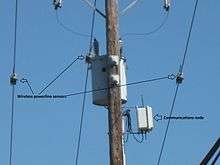Wireless powerline sensor

A Wireless powerline sensor hangs from an overhead power line and sends measurements to a data collection system. Because the sensor does not contact anything but a single live conductor, no high-voltage isolation is needed. The sensor, installed simply by clamping it around a conductor, powers itself from energy scavenged from electrical or magnetic fields surrounding the conductor being measured.[1] Overhead power line monitoring helps distribution system operators provide reliable service at optimized cost.[2][3]
Communication


In the photos on the right, an antenna on the sensor transmits data to a communication device attached to a nearby utility pole. The communication device gets power from the 240 Volt utility line in a residential neighborhood. The device has two antennas. One antenna collects data from the sensors, and the other antenna forwards the data to the electrical utility control center over cell phone service.
In some systems, powerline sensors may transmit information on the high voltage conductor itself rather than by transmission of a radio signal.[4][5]
Measurements
The primary purpose of a powerline sensor is to measure current, however, some sensors can either directly measure or derive other data such as:
- Conductor temperature
- Ambient temperature
- Inclination or the amount of line sagging
- Wind movement
- Electric fields
- Power Generation
- Distribution and Consumption of electricity
See also
- Energy management system (EMS)
- List of wireless sensor nodes
- Sensor node
- Supervisory control and data acquisition (SCADA)
- Wireless sensor network (WSN)
References
- ↑ Yang,, Yi (April 26, 2011), Power Line Sensor Networks for Enhancing Power Line Reliability and Utilization (PDF), Georgia Institute of Technology
- ↑ Zhao, X.; Keutel, T.; Baldauf, M.; Kanoun, O. (2013). "Energy harvesting for a wireless-monitoring system of overhead high-voltage power lines". IET Generation, Transmission & Distribution. 7 (2): 101–107. doi:10.1049/iet-gtd.2012.0152.
- ↑ Yi Yang; Divan, D.; Harley, R. G.; Habetler, T. G. (2006). "Power line sensornet - a new concept for power grid monitoring". 2006 IEEE Power Engineering Society General Meeting. pp. 8 pp. ISBN 1-4244-0493-2. doi:10.1109/PES.2006.1709566.
- ↑ Casaca, A. ; Pereira, P. ; Buttyan, L. ; Goncalves, J. ; Fortunato, C. A (June 25–27, 2012). Wireless Sensor and Actuator Network for improving the electrical power grid dependability. Next Generation Internet (NGI), 2012 8th EURO-NGI Conference. Karlskrona Sweden: IEEE. pp. 71–78. doi:10.1109/NGI.2012.6252167.
- ↑ Cigdem E., Merve S.,Vehbi Cagri G., Etimad F., Ian F. "A. Lifetime analysis of wireless sensor nodes in different smart grid environments". 20 (7). Wireless Networks: 2053–2062. doi:10.1007/s11276-014-0723-0.
External links
- A Wireless Sensors Suite for Smart Grid Applications
- Power Line Monitoring for Energy Demand Control
- Specifications for a commercially available product